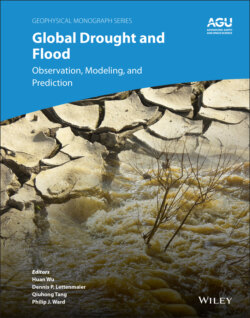Читать книгу Global Drought and Flood - Группа авторов - Страница 14
ABSTRACT
ОглавлениеDrought, one of the most daunting natural hazards, is linked to other hazards such as heatwaves and wildfires, and is related to global and regional food security. Given the severe environmental and socioeconomic ramifications of droughts, comprehensive and timely analysis of droughts’ onset, development, and recovery at proper spatial and temporal scales is of paramount importance. Droughts are categorized by different variables, such as precipitation, soil moisture, and streamflow, depending on the target of the analysis. The root cause of droughts, however, is sustained below‐average precipitation. Large‐scale oceanic and atmospheric circulations drive precipitation variability, and hence droughts should be analyzed from a continental to global perspective. Given the spatial scale of interest, as well as the poor spatial resolution and temporal inconsistency of ground observations, multisensor remotely sensed climatological, hydrological, and biophysical variables offer a unique opportunity to model droughts from different perspectives (meteorological, agricultural, hydrological, and socioeconomic) and at the global scale. It is also often required to model droughts using multiple indices and analyze feedbacks between droughts and other hazards, such as heatwaves. Multiple satellites, missions, and sensors offer invaluable information for multi‐indicator modeling of droughts and their feedbacks with other natural hazards in an era of big data. Remote sensing satellite data, however, are associated with major challenges including temporal limitations, consistency within and between multiple sensors and data sets, reliability, lack of uncertainty assessment, managing data volumes, and paucity of research on translating remote sensing of drought into actionable science. With challenge comes opportunity. The focus of the scientific community should be on merging the information provided from different satellites and sensors, to underpin their uncertainties, and to offer long‐term and consistent data sets for drought analysis.
